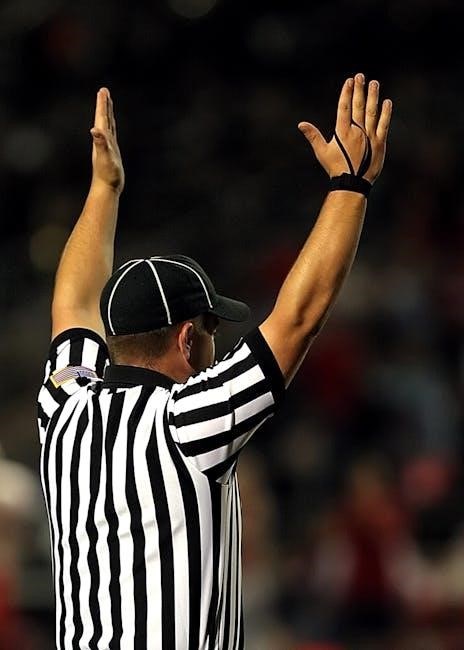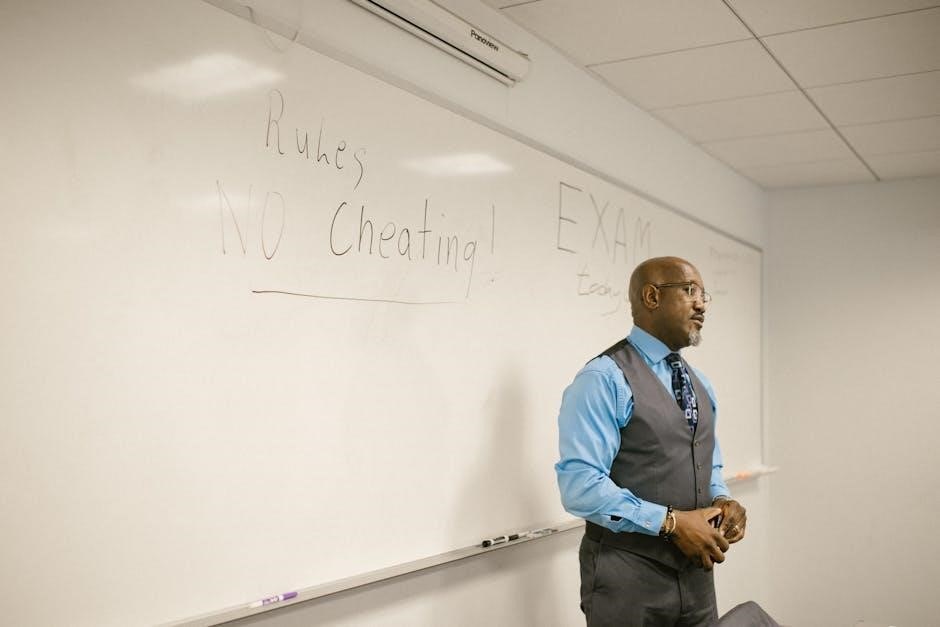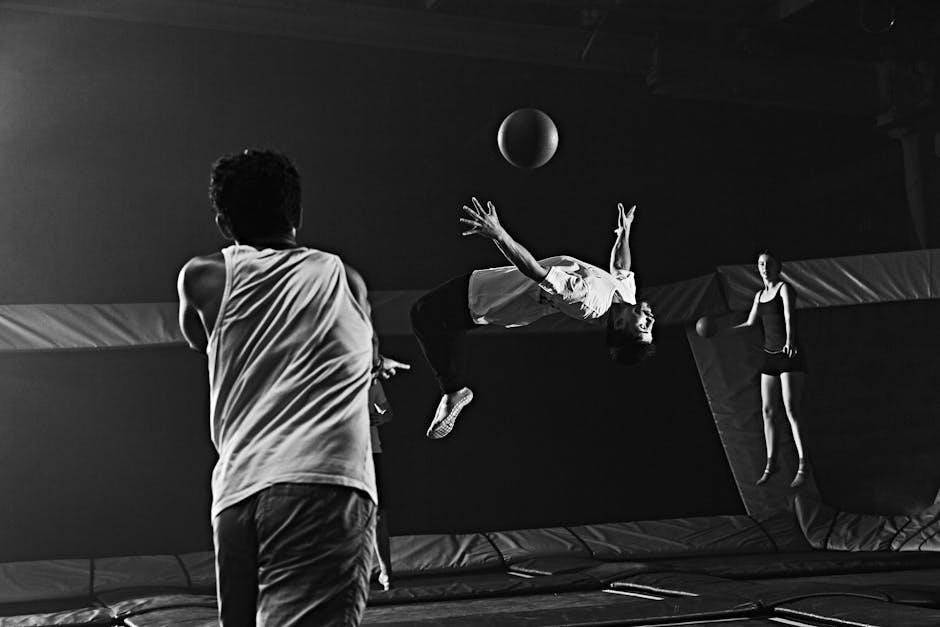Dodgeball rules outline the gameplay, safety, and sportsmanship standards․ The National Amateur Dodgeball Association (NADA) provides official guidelines, covering team composition, equipment, and match procedures to ensure fair play․
Overview of the Game and Its Objectives
Dodgeball is a fast-paced team sport where players aim to eliminate opponents by hitting them with balls below the shoulders or catching thrown balls․ Teams start with six players on the field, and the objective is to outlast the opposing team․ Strategy, coordination, and quick reflexes are key to success․ The game emphasizes fair play and sportsmanship, ensuring an exciting and competitive experience for all participants․

Team Composition and Player Requirements
Teams consist of 6-10 players, with 6 starting and substitutes available․ Co-Rec teams must maintain gender balance, and all players must meet uniform requirements․
Team Size and Substitute Rules
Teams consist of 6-10 players, with 6 starting on the field․ Substitutes can enter only during timeouts or in case of injury․ Each team must maintain uniform requirements for all players, ensuring consistency and fairness during gameplay․ Substitutions are strategically managed to optimize team performance without disrupting the flow of the match․
Co-Rec Team Rules and Gender Balance
Co-Rec teams must maintain gender balance, ensuring no more male players than female players on the field at the start of each game․ This rule promotes inclusivity and fair competition․ Teams must adhere to this balance to avoid penalties, emphasizing equal participation and sportsmanship in mixed-gender dodgeball matches․
Game Setup and Field Layout
The field features sidelines, end lines, attack lines, and a center line․ Balls are evenly placed along the center line at the start of each match․
Field Boundaries and Attack Lines
The field is defined by sidelines, end lines, and attack lines․ Players must remain within these boundaries during play․ The attack line marks the area players must stay behind until the game starts․ Crossing the attack line before the whistle results in a violation․ The center line divides the field, with balls placed along it at the start of each match․
Center Line and Ball Distribution
The center line divides the field into two equal halves․ At the start, dodgeballs are placed along this line․ Players rush to retrieve the balls after the whistle․ Each team must bring the balls back to their side behind the attack line before they can be legally thrown․ Proper ball distribution is essential for gameplay fairness and safety․

Gameplay Basics
The game begins with players rushing to the center line to retrieve balls․ The objective is to eliminate opponents by hitting them with balls or catching throws․
How the Game Starts and Objectives
The game begins with players positioned behind their respective end lines․ Upon the referee’s whistle, players rush to the center line to retrieve the dodgeballs․ Once a ball is picked up, it must be taken behind the attack line before it can be legally thrown․ The primary objective is to eliminate opposing players by hitting them with a ball below the shoulders or catching a thrown ball․ Teams aim to be the last ones standing on the court․
Elimination Methods and Catching Rules
Players are eliminated if hit by a ball below the shoulders or if they drop a caught ball․ Catching a live ball thrown by an opponent eliminates the thrower and returns a caught-out teammate․ A caught ball must be secured before hitting the ground to count․ Headshots and unsafe throws may result in penalties or warnings from officials, ensuring player safety and fair play throughout the game․

Equipment and Safety Standards
Official dodgeballs must meet size and material specifications․ Players must wear non-marking shoes and approved eyewear․ Safety guidelines ensure proper ball weight and prohibit dangerous throws above the shoulders․
Official Dodgeball Specifications
Official dodgeballs must be 8-10 inches in circumference, weighing 14-16 ounces․ They are made of rubber or synthetic materials, ensuring grip and safety․ The balls must be evenly distributed at the center line․ No modified or dangerous balls are allowed․ Proper inflation is required to prevent injury․ These specifications ensure consistent gameplay and safety, adhering to NADA standards for fair and regulated competition․
Player Uniform and Gear Requirements
Players must wear approved uniforms, including matching shirts, shorts, and non-marking athletic shoes․ Metal cleats and dangerous accessories are prohibited․ Uniforms must display team numbers clearly․ All players must wear required protective gear, such as mouthguards, if mandated by league rules․ Officials will inspect uniforms and gear before games to ensure compliance with safety and regulations․ Proper attire is essential for participation and fair play․
Officials and Their Roles
Referees and scorekeepers ensure fair play by enforcing rules, tracking eliminations, and managing game flow․ Their decisions are final, maintaining the integrity and smooth progression of the match․
Duties of Referees and Scorekeepers
Referees enforce rules, monitor gameplay, and make calls on hits, catches, and violations․ They ensure player safety and maintain game flow․ Scorekeepers track eliminations, timeouts, and scores, providing accurate match data․ Their roles are crucial for fair play and smooth game management, adhering to official dodgeball standards as outlined in the NADA Rule Book․
Enforcing Rules and Penalty Calls
Referees enforce rules by calling penalties for violations like headshots, stalling, or out-of-bounds plays․ Penalties may result in player elimination or timeouts․ Officials ensure fair play by consistently applying rules and addressing misconduct․ Their decisions are final, maintaining the integrity and safety of the game as per NADA guidelines․
Penalties and Violations
Penalties include headshots, stalling, and illegal throws․ Violations result in player elimination or timeouts, ensuring fair play and safety as per official dodgeball rules․
Common Penalties and Their Consequences
Common penalties include hitting above the shoulders, stalling, and illegal throws․ Consequences may involve player elimination, timeouts, or ball possession reversal․ Repeated violations can lead to warnings or ejections, ensuring adherence to safety and fair play standards outlined in official dodgeball rules․
5-Second Violation and Stalling Rules
A 5-second violation occurs when a team controlling all six balls on their side exceeds the time limit․ This rule prevents stalling and promotes aggressive play․ If violated, the opposing team gains possession of all balls, encouraging dynamic gameplay and maintaining match momentum as per official dodgeball regulations․

Timeouts and Substitutions
Timeouts last 30 seconds, allowing teams to strategize․ Substitutions occur during timeouts or injuries, ensuring seamless player rotation without disrupting gameplay flow as per official rules․
Timeout Duration and Usage
Timeouts in dodgeball last 30 seconds, providing teams a brief pause to strategize․ Teams are allowed a limited number of timeouts per game, as specified by the rules․ Timeouts can be called by team captains or coaches to regroup, discuss tactics, or address player injuries․ Officials strictly enforce timeout duration, ensuring the game resumes promptly after the allocated time․ Proper use of timeouts is crucial for maintaining gameplay flow and fairness․
Substitution Procedures During the Game
Substitutions in dodgeball occur during timeouts or due to injury․ Teams must notify officials before making substitutions, ensuring the player exits and the substitute enters legally․ Proper documentation, such as a substitution list, is required for verification․ Unauthorized substitutions or unsportsmanlike conduct may result in penalties․ Adhering to these procedures maintains game integrity and ensures fair play, as outlined in official dodgeball rules․

Scoring and Winning the Game
Points are awarded based on wins, losses, and draws․ A win grants three points, a loss one, and a draw two․ The game is won by eliminating all opponents or having more players remaining when time expires․
Points System and Winning Conditions
The scoring system allocates three points for a win, one for a loss, and two for a draw․ A match is won by eliminating all opposing players or having the most players remaining when time expires․ Overtime rules apply if the game is tied, ensuring a fair resolution․ These conditions ensure clear outcomes and maintain competitive fairness in dodgeball matches․
Overtime Rules and Tiebreakers
Overtime occurs if the score is tied at the end of the match․ Teams reduce to three players per side, and the first to eliminate the opposing team wins․ If still tied, sudden-death rules apply, where the next elimination determines the winner․ These tiebreakers ensure a decisive outcome, maintaining the game’s competitive integrity and preventing indefinite matches․

Advanced Strategies and Tips
Advanced strategies emphasize teamwork, communication, and positioning․ Players should focus on misdirection, fakes, and targeting weaker opponents․ Balancing offense with defense is key, ensuring coverage of all angles․
Offensive and Defensive Tactics
Offensive strategies involve aggressive ball retrieval and coordinated attacks․ Players should aim for precise throws targeting opponents’ mid-sections․ Defensive tactics focus on spreading out, catching thrown balls, and protecting team members․ Proper positioning behind boundaries and effective communication enhance both offense and defense, ensuring team cohesion and strategic gameplay execution․ Timing and adaptability are crucial for success in both approaches․
Team Coordination and Communication
Effective team coordination and communication are vital for success․ Players must work together, calling out opponents’ positions and signaling ball locations․ Clear communication ensures synchronized attacks and defensive strategies, preventing confusion․ Teammates should assign roles, such as throwers and catchers, to maximize efficiency․ Strong coordination enhances overall performance, fostering trust and unity among players during high-intensity matches․ Open dialogue is essential for quick decision-making and adapting to game dynamics․
Rule Variations and Exceptions
Rule variations and exceptions adapt dodgeball for different leagues and formats, ensuring flexibility while maintaining core gameplay integrity․ These adjustments cater to specific tournament needs and player preferences․
Co-Rec Specific Rule Modifications
Co-Rec teams must maintain gender balance, starting games with no more male than female players․ This ensures inclusivity and fair competition, promoting equal participation from all team members․ Specific modifications include requirements for minimum female involvement and rules to prevent dominance by one gender, fostering a balanced and enjoyable playing environment for everyone involved in the game․
League-Specific Variations and Adjustments
Leagues often adapt official rules to suit their needs, such as adjusting team sizes or modifying gameplay durations․ Some leagues introduce unique variations, like altered ball numbers or special scoring systems․ These adjustments aim to enhance competition or accommodate specific formats, ensuring the game remains dynamic and engaging while maintaining core principles of fairness and sportsmanship across all participating teams․

Resources and Further Reading
Find detailed dodgeball rules in the official National Amateur Dodgeball Association (NADA) Rule Book․ Visit their website for updates, guides, and training materials to enhance your understanding of the game;
Official NADA Rule Book and Updates
The official National Amateur Dodgeball Association (NADA) Rule Book provides comprehensive guidelines for dodgeball․ It includes rules on team composition, gameplay, and safety standards․ Updated annually, the rulebook ensures fair play and sportsmanship․ The 2025 season updates focus on enhancing gameplay and reducing stalling․ Players and teams can purchase the complete rulebook on the NADA website for $3 (non-members) or $2․50 (members)․ Regular updates are posted online to keep the sport evolving fairly and safely․
Additional Guides and Training Materials
Beyond the official NADA Rule Book, additional resources are available to enhance understanding and skill․ Strategy guides, training videos, and workshops offer insights into advanced tactics․ Many leagues provide supplementary materials, such as clinics led by experienced players․ These resources help teams improve coordination and master gameplay․ Stay updated with the latest training materials to elevate your dodgeball skills and ensure compliance with evolving rules and regulations․



